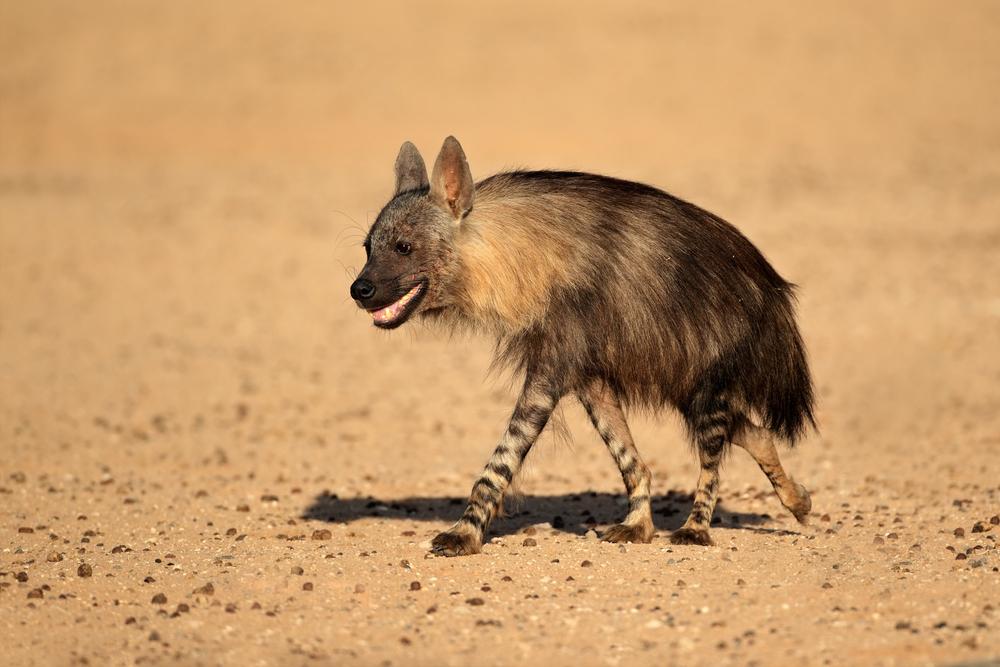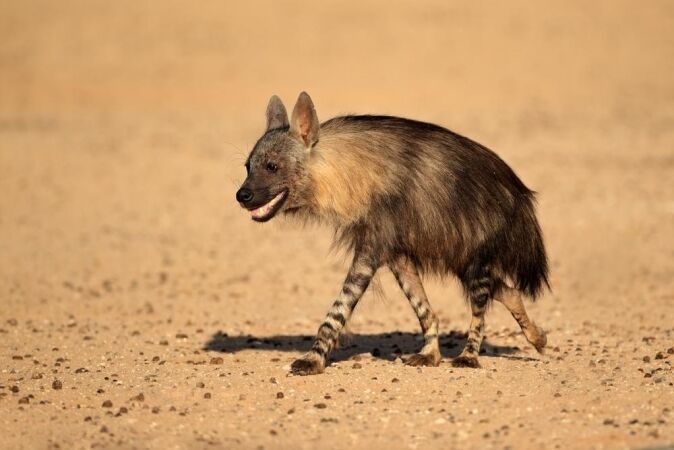

The brown hyena (Parahyaena brunnea) is a species of hyena found in Namibia, Botswana, western and southern Zimbabwe, Mozambique, and South Africa. Listed on the International Union for Conservation of Nature (IUCN) as near threatened, the hyena requires a Threatened or Protected Species (TOPS) permit arranged before the game hunting safari.
Also known in South Africa as the “strandwolf” (beach wolf), the brown hyena lives in southern and western African coastal desert areas. It inhabits desert areas, semi-desert, and open woodland savannahs. Hyenas are omnivores. Their diet consists of birds, eggs, insects, and fruit, while they scavenge leftovers from lion, cheetah, and spotted hyena kills. By consuming fruit with a high water content, they can survive in more arid areas than other hyena species, where they do not have daily access to water. They are nocturnal and far more active at night to avoid the harsh sun and high temperatures, allowing for easier and better hunting conditions in the cooler evenings.
They mate primarily from May to August. Males and females in the same clan usually do not mate with each other, and females tend to mate with nomadic males. Between 1-5 cubs are born after a gestation period of around 90 days. Although the mother hyena will kill other cubs in the same clan, she is a diligent and caring mother and sees to her cubs even after they are weaned.
Name:
Parahyaena Brunnea
Weight:
89-98 pounds
Range:
Namibia, Botswana, Zimbabwe, Mozambique and South Africa
Mating Season:
May-August
Life span:
12-15 years
Brown Hyena’s Can be Hunted with a TOPS Permit Prior to the Game Hunting Safari.
Brown hyenas can be differentiated from other species of hyena by their long, dark brown shaggy coat and a short tail. The adults have cream-colored fur around their necks, and their legs are white and brown striped. They are the second largest hyena species, only smaller than the spotted hyena. There isn’t any noticeable size difference between male and female brown hyenas, although males may be slightly larger than their female counterparts. Male hyenas weigh 89-98 pounds, while females weigh 83-89 pounds. The shoulder height is around 28–31 inches, and the tail is 9.8–13.8 inches. During confrontations with other animals, the brown hyenas will raise their mane and fluff out their creamy-colored fur ruff around their necks, to make them look even larger and more intimidating, to scare off predators or competition.
Brown hyenas are listed by the IUCN as being on the “near threatened” list, but they are still allowed to be targeted if a permit has been obtained. When hunting hyenas, a Threatened or Protected Species (TOPS) permit must be acquired before the game hunting safari. These trophies are not allowed to be imported into the USA. The hunting safari will involve three possible methods to hunt the brown hyena. Firstly, a blind can be set with bait for the hyena to come and from which to scavenge. Secondly, walking and stalking it in its natural environment is a more popular method while those wanting to indulge in a nocturnal hunting adventure, the brown hyena can also be targeted by spotlight when hunting in South Africa.
An interesting specialty animal for any game hunting safari, the brown spotted hyena is a good trophy to hunt, but consider any import laws that may apply. A tip with hunting hyenas is always to ensure that they are actually dead; a wounded hyena is extremely dangerous and a face-to-face encounter with an animal that can crack a springbok’s bones in its jaws is not recommended!
Brown hyenas are listed by the IUCN as being on the “near threatened” list, but they are still allowed to be targeted if a permit has been obtained. When hunting hyenas, a Threatened or Protected Species (TOPS) permit must be acquired before the game hunting safari. These trophies are not allowed to be imported into the USA. The hunting safari will involve three possible methods to hunt the brown hyena. Firstly, a blind can be set with bait for the hyena to come and from which to scavenge. Secondly, walking and stalking it in its natural environment is a more popular method while those wanting to indulge in a nocturnal hunting adventure, the brown hyena can also be targeted by spotlight when hunting in South Africa.
Search from our range of Hunts across various popular destinations in Africa.
Find A Hunt